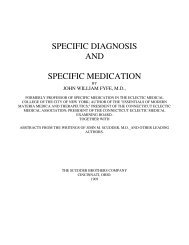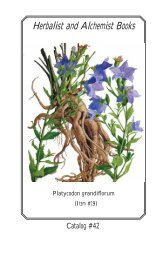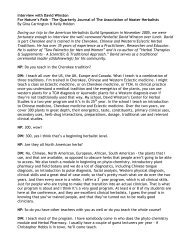MEDlCINAL PLANTS OF JAMAICA. PARTS 1 & 11.
MEDlCINAL PLANTS OF JAMAICA. PARTS 1 & 11.
MEDlCINAL PLANTS OF JAMAICA. PARTS 1 & 11.
Create successful ePaper yourself
Turn your PDF publications into a flip-book with our unique Google optimized e-Paper software.
Red birch appears to find little application in Jamaican domestic medicine though it may, on occasions, be used,<br />
perhaps with Argemone mexicana, as a treatment for high blood pressure. (1, 15, 16, 24, 27, 28, 37, 38, 47, 56).<br />
CAESALPINOIDEAE<br />
CAESALPINEA BONDUC Roxb. i (Nicker); Nichol (Yellow and Grey).<br />
C. BONDUCELLA Flem.('<br />
Since our previous account of these species it has become apparent that the generally accepted common<br />
name in Jamaica is nichol (nickel) rather than nicker. A recent communication indicates that the use of the seeds<br />
by diabetics is fraught with danger owing to the fact that they contain a principle which suppresses urinary<br />
sugar while leaving the blood sugar unaffected. We have so far been unable to locate an account of the<br />
investigations on which this statement is based.<br />
We further find that the seeds have been used tn the treatment of venereal diseases, being regarded as<br />
astringent. Both leaves and seeds have been used as an external application for hydrocoele while the leaves,<br />
which are said to be rubefacient, have been applied to aching teeth and used in cases of rheumatismand palsy<br />
and to prepare a gargle. The seeds have also been thought of value in the treatment of convulsions. The root,<br />
and especially its bark, was also considered of value in the treatment of intermittent fever. (3, 5, 7, 8, 9, 10, 11,<br />
15, 16, 17, 19, 24, 26, 27, 29, 37, 38, 39, 47, 50, 53, 61, 62).<br />
CASSIA FISTULA L. Indian Laburnum; Cassia Stick Tree; Purging Cassia.<br />
Small doses of the fruit pulp, which is rich in sugar, tannin and citric acid, is a well-known gentle laxative.<br />
The pulp is also said to contain about one per cent of an anthraquinone derivative, gum and traces of<br />
volatile oil. It was an ingredient of confection of senna. Dancer gave the dose as a portion the size of a small<br />
nutmeg. In larger doses it is purgative. In Jamaica the pulp is still sometimes used with a senna as a purge. The<br />
seeds also are said to be purgative. In Rhodesia the plant is used by the natives in the treatment of malaria,<br />
black-water fever, blood poisoning, dysentery and anthrax. Cassia pulp has found some use in India as an<br />
external application in cases of gout and rheumatism. It was, in the past, included in the pharmacopoeias. The<br />
bitter root is said to be febrifuge and diuretic and in Ceylon the bark is used as a treatment for rheumatism. A<br />
confection of the flowers is also considered febrifuge. The bark and leaves have been used in the East as an<br />
external application for skin diseases. (3,5, 8, 9, 10, 11, 14, 15, 16, 17, 22, 23, 26, 27, 37, 39, 47, 61. 62).<br />
CASSIA LlGUSTRINA L. Dandelion: Piss-a-bed.<br />
C. OCCIDENTALIS L.Dandelion: Piss-a-bed.<br />
CASSIA SP.Dandelion.<br />
Considerable confusion appears to exist among Jamaicans who use "tea bushes" as to the identity and<br />
respective merits of the plants called dandelion and piss-a-bed. It is certain that some informants who claim that<br />
the plants are different distinguish them on characteristics of so slight a botanical nature that they have<br />
presented to us specimens of C. occidentalis under both names: we have, moreover, been assured that, while<br />
piss-a-bed is given to children (and adults) with weak bladders, dandelion is "good for the kidneys" which<br />
seems to imply a diuretic character. Both Dancer and Wright give the name piss-a-bed to C. occidentalis which<br />
they describe as diuretic and aperient. Other writers describe the root only, as diuretic. We have had similar<br />
confused accounts of C. ligustrina. At Bath an informant identified C. occidentalis as piss-a-bed and attributed<br />
to it antidiuretic properties: the plant presented as dandelion was a further unidentified Cassia sp. which was<br />
described as "good for" the kidneys, back pains, the stomach and shortness of breath.<br />
C. ligustrina-The leaves of this species are employed in Cuba as a purge.<br />
C. occidentalis-In addition to uses already recorded the leaves of this species are described in the literature as<br />
providing a drink and wash for skin diseases; the seeds as an application for ringworm; and the leaves and roots<br />
a3 a medicine for jaundice, dropsy, dysentery, diarrhoea, liver troubles and gonorrhoea. We have also been told<br />
that the plant (with soil still adhering to the roots) soaked in proof rum makes an excellent medicine for the<br />
prevention of an attack of malaria. (2, 3, 5. 8. 9, 10. 14, 15.16. 19, 24, 25, 26, 27, 37, 39, 47, 48, 51, 58, 60,<br />
61, 62).







